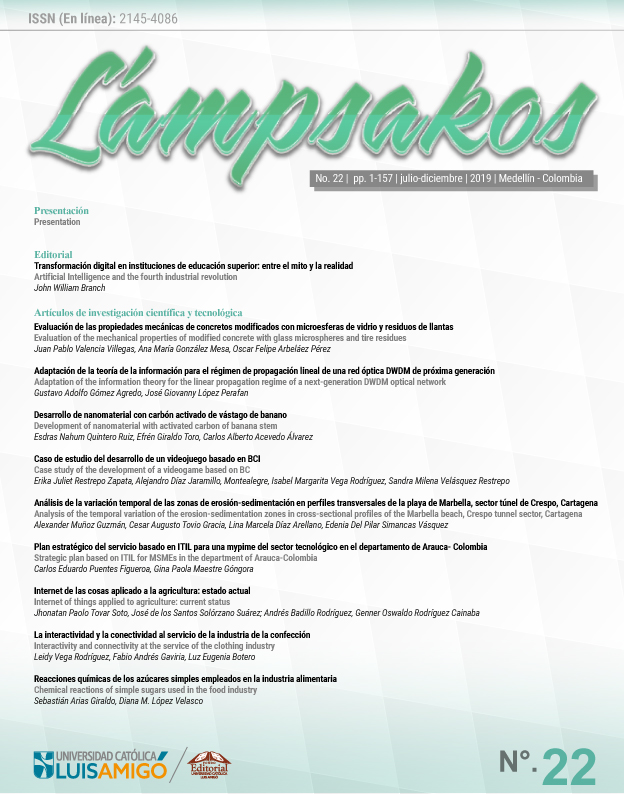Adaptation of information theory to the linear propagation regime of a next-generation DWDM optical network
DOI:
https://doi.org/10.21501/21454086.3127Keywords:
Information theory, Optical networks, DWDM, FSAN, Spectral efficiency, Bandwidth, Channel capacity.Abstract
In the development of the present article, the information theory of Shannon is adapted and equation is proposed for the measurement of the spectral efficiency in order to be applied to the new optical network environments NG-PON (Next Generation Passive Optical Network) proposed by the FSAN task group (Full Service Access Network) of ITU-T. This development will allow to control certain parameters and configuration characteristics of the systems based on optical fiber to achieve improvements in the spectral efficiency, high access capacities and large bandwidths; allowing to understand in a clearer way, the changes that the DWDM network architectures (Dense Wavelength Division Multiplexing) have suffered in recent years as a vision of the future of telecommunicationsDownloads
References
S. D. N., UIT, “Visión general de las redes de próxima generación”, Recommendation UIT-T Y. 2001, Ginebra, pp. 2, 2004.
FSAN. Full Service Access Network, “comité desarrollador UIT”, Página Web Retrieved from https://www.fsan.org/.
Rong Zhao et al., “FTTH Handbook”, Fibre to the Home Council Europe, Wettelijk Depot, 2018.
S. D. N., UIT, “10-Gigabit-capable passive optical network (XG-PON) systems: Definitions, abbreviations and acronyms”, Recommendation UIT-T. G. 987, Ginebra, 2012.
S. D. N., UIT, “10-Gigabit-capable passive optical networks (XG-PON): General requirements”, Recommendation UIT-T. G. 987.1, Ginebra, 2016.
S. D. N., UIT, “10-Gigabit-capable passive optical networks (XG-PON): Physical media dependent (PMD) layer specification”, Recommendation UIT-T. G 987.2, Ginebra, 2016.
S. D. N., UIT, “10-Gigabit-capable passive optical networks (XG-PON): Transmission convergence (TC) layer specification”, Recommendation UIT-T. G. 987.3, Ginebra, 2014.
S. D. N., UIT, “10 Gigabit-capable passive optical networks (XG-PON): Reach extensión”, Recommendation UIT-T. G 987.4, Ginebra, 2012.
S. D. N., UIT, “10-Gigabit-capable symmetric passive optical network (XGS-PON)”, Recommendation UIT-T. G. 9807.1, Ginebra, 2016.
S. D. N., UIT, “10 Gigabit-capable passive optical networks (XG(S)-PON): Reach extensión”, Recommendation UIT-T. G. 9807.2, Ginebra, 2017.
S. D. N., UIT, “40-Gigabit-capable passive optical networks (NG-PON2): General requirements”, Recommendation UIT-T. G 989.1, Ginebra, 2013.
S. D. N., UIT, “40-Gigabit-capable passive optical networks 2 (NG-PON2): Physical media dependent (PMD) layer specification”, Recommendation UIT-T. G 989.2, Ginebra, 2019.
S. D. N., UIT, “40-Gigabit-capable passive optical networks (NG-PON2): Transmission convergence layer specification”, Recommendation UIT-T. G 989.3, Ginebra, 2015.
C. E. Shannon, “A mathematical theory of communication”, The Bell System Technical Journal, Vol. 27, pp. 379–423, 623–656, 1948. Available: http://www.math.harvard.edu/~ctm/home/text/others/shannon/entropy/entropy.pdf
H. Simon, Sistemas de Comunicación, 2da edición. Madrid, España: Limusa Wiley, 2001.
J. G. Proakis, and M. Salehi, Digital communications. Fifth Edition. New York: McGraw-Hill, 2007.
R. G. Gallager, Information theory and reliable communication. New York: Wiley, 1968.
E. Desurvire, Classical and quantum information theory: an introduction for the telecom scientist. Cambridge: University Press, 2009.
J. M. Kahn, K. P. Ho, “Ultimate spectral efficiency limits in DWDM systems”, In OptoElectronics and Communications Conference, 2002, pp. 8-12.
K. P. Ho, J. M. Kahn, ”Channel capacity of WDM systems using constant-intensity modulation formats”, In Optical Fiber Communication Conference (p. ThGG85), Optical Society of America, March, 2002.
A. Mecozzi, M. Shtaif, “On the capacity of intensity modulated systems using optical amplifiers”, IEEE Photonics Technology Letters, 13(9), 1029-1031, 2001.
E. E. Narimanov, P. Mitra, “The channel capacity of a fiber optics communication system: Perturbation theory”, Journal of lightwave technology, 20(3), 530, 2002.
P. P. Mitra, J. B. Stark, “Nonlinear limits to the information capacity of optical fibre communications”, Nature, 411(6841), 1027. 2001.
I. Brener et al., “Cancellation of all Kerr nonlinearities in long fiber spans using a LiNbO 3 phase conjugator and Raman amplification”, In Optical Fiber Communication Conference, 2000. doi: 10.1109/OFC.2000.869479
P. J. Winzer, and R. J. Essiambre, “Advanced optical modulation formats”, Proceedings of the IEEE, vol. 94, no. 5, pp. 952-985, 2006. doi: 10.1109/JPROC.2006.873438
G. Gómez, “Mejora de la Eficiencia Espectral en redes DWDM a 40Gbps a través de los formatos de modulación avanzados DPSK y DQPSK”, (Tesis de maestría), Universidad del Cauca, 2019.
Downloads
Published
How to Cite
Issue
Section
License
In accordance with national and international copyrights, as well as publishing policies of "Fundación Universitaria Luis Amigó" and its Journal "Lámpsakos" (indexed with ISSN : 2145-4086), I (we ) hereby manifest:1. The desire to participate as writers and submit to the rules established by the magazine publishers.
2. The commitment not to withdraw the manuscript until the journal finishes the editing process of the ongoing issue.
3. That article is original and unpublished and has not been nominated or submitted together in another magazine; therefore, the rights of the article in evaluation have not been assigned in advance and they do not weigh any lien or limitation for use.
4. The absence of conflict of interest with commercial institution or association of any kind
5. The incorporation of the quotes and references from other authors, tending to avoid plagiarism. Accordingly, the author affirms that the paper being published do not violate copyright, intellectual property or privacy rights of third parties. Morover, if necessary there is a way of demonstrating the respective permits original copyright to the aspects or elements taken from other documents such as texts of more than 500 words, tables, graphs, among others. In the event of any claim or action by a third party regarding copyright on the article, the author (s) will assume full responsibility and come out in defense of the rights herein assigned. Therefore, for all purposes, the Journal "Lámpsakos" of the "Fundación Universitaria Luis Amigó" acts as a third party in good faith.
6. In the event of the publication of the article, the authors free of charge and on an exclusive basis the integrity of the economic rights and the right to print, reprint and reproduction in any form and medium, without any limitation as to territory is concerned, in favor of the Journal "Lámpsakos" of the "Fundación Universitaria Luis Amigó".








